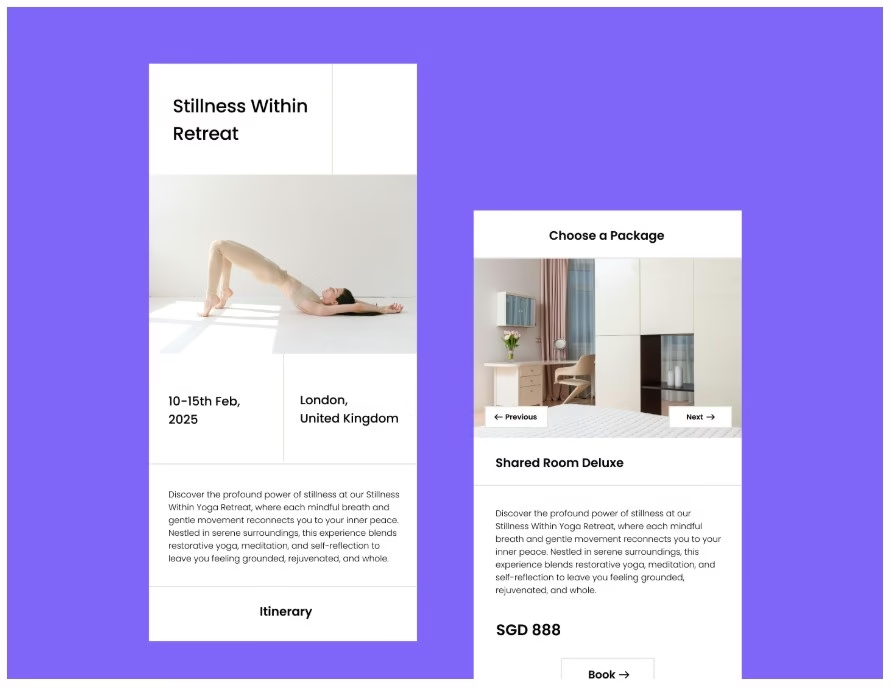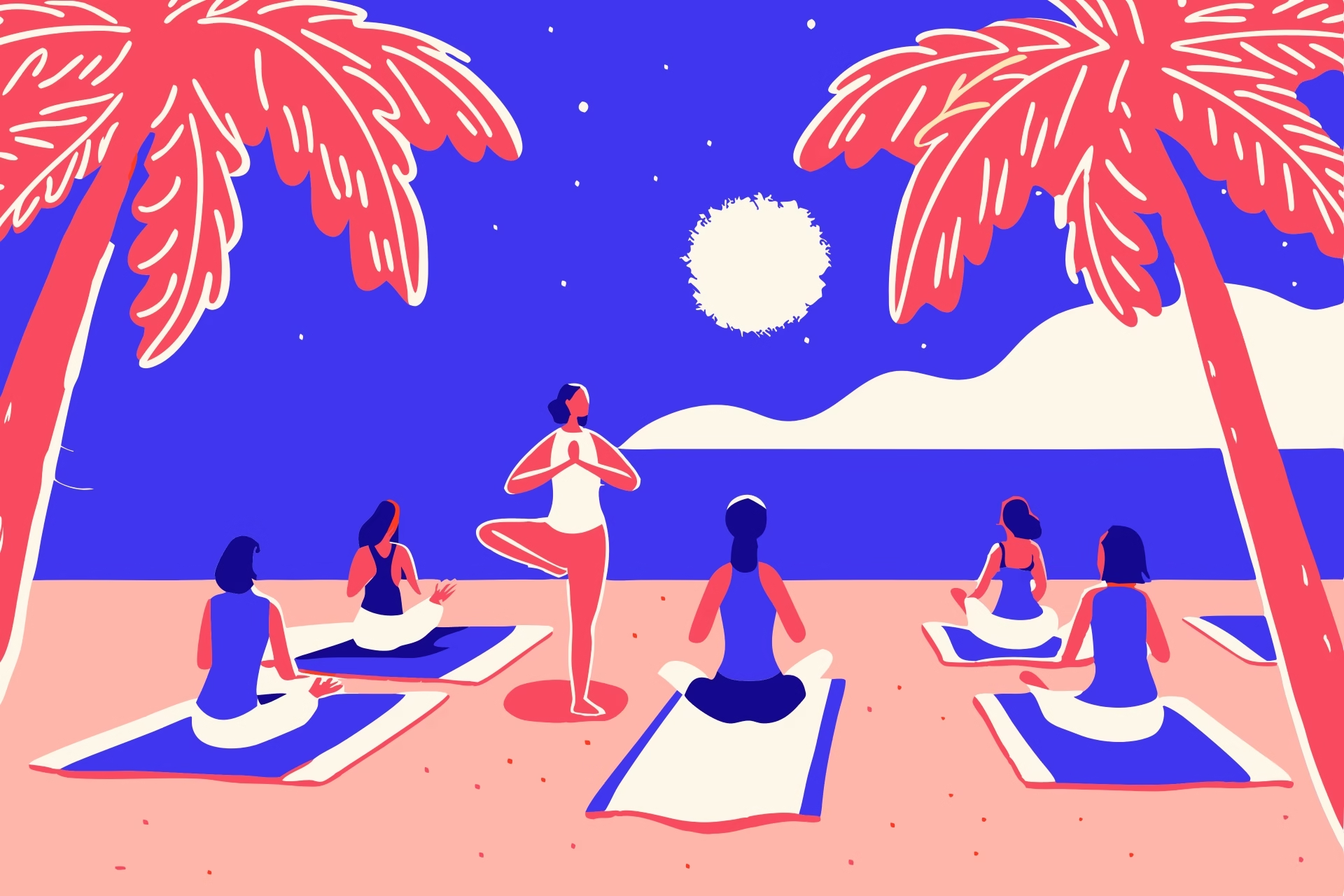You’ve probably seen a hundred wellness websites—some beautiful, some forgettable, and a few that seem to magically draw you in.
But what makes the best wellness website actually work?
What separates a site that feels calming, inspiring, and trustworthy from one that just… exists?
The truth is, that a great wellness website design isn’t just about aesthetics.
It’s about psychology, strategy, and user experience. A stunning design won’t do much if visitors get lost, don’t connect with your message, or can’t find the information they need.
So, if you’re a wellness coach, studio owner, or holistic practitioner building (or revamping) your site, here’s what you need to create a website that doesn’t just look good—but actually converts visitors into loyal clients.
1. Make Your Message Impossible to Ignore

The second someone lands on your wellness website, they should immediately know they’re in the right place.
Who you are, what you do, and—most importantly—why it matters to them should be crystal clear. Visitors don’t read—they scan. That means your website has to hook them fast.
How to make that happen:
- Lead with a bold, benefit-driven headline (e.g., “Helping Burnt-Out Professionals Reclaim Their Energy Through Holistic Coaching”). Make it about them, not just you.
- Ditch the generic “Welcome to my site.” Instead, open with a transformation statement that speaks to their struggles and goals.
- Make your CTA impossible to ignore. Skip the vague “Contact Me” and go for something action-driven, like “Let’s Map Out Your Wellness Journey—Book a Free Call.”
Your homepage isn’t a brochure—it’s an open invitation. Make visitors feel seen, understood, and excited to take the next step.
2. Design for the ‘Lazy Scroller’
Let’s be real—no one is meticulously reading every word on your wellness website.
They’re skimming, scrolling, and looking for quick answers. If your site isn’t structured for effortless browsing, you’re losing potential clients before they even process what you offer.
How to make your site skimmer-friendly:
- Chunk your content. Use bold headings, short paragraphs, and bullet points so visitors can grasp key points in seconds.
- Guide their eyes. Make your most important information (like your services, pricing, and CTAs) stand out visually with strategic spacing and contrast.
- Keep navigation brain-dead simple. Think: Home, About, Services, Testimonials, Contact. The fewer clicks to find what they need, the better.
If visitors have to work to figure things out, they’ll bounce. Make their experience seamless, and they’ll stay long enough to book, buy, or subscribe.
3. Turn Testimonials into Irresistible Proof

People don’t just want to hear that your wellness services work—they want evidence.
A generic “I loved working with Sarah” won’t move the needle. Your social proof should feel as compelling as a personal recommendation from a trusted friend.
How to make testimonials actually convert:
- Tell a transformation story. Instead of “I loved working with Sarah,” try: “I came to Sarah feeling overwhelmed and exhausted. Three months later, I wake up energized and excited about my day again.”
- Show before-and-after results. Whether it’s a physical, emotional, or lifestyle shift, visualizing change makes an impact.
- Use case studies. Walk potential clients through a real client’s journey—where they started, what you did together, and how their life improved.
- Leverage credibility. Worked with notable brands, studios, or experts? Showcase their logos to build instant trust.
The right social proof doesn’t just say you’re good—it proves it in a way that makes people think, I want that transformation, too.
4. Make Your Blog a Client-Attracting Machine
Most wellness blogs are nice to have—but if you’re strategic, yours can be a lead-generating powerhouse.
Instead of posting random thoughts, use your blog to answer the exact questions potential clients are already searching for.
How to turn your blog into a magnet for clients:
- Write what people are actually Googling. Check out “People Also Ask” on Google to find high-interest topics that bring in organic traffic.
- Create content that never goes out of style. “5 Morning Rituals to Reduce Stress” will stay relevant—“What I Learned from Last Week’s Meditation” won’t.
- Make every post work for you. Add a CTA in every article—whether it’s booking a session, grabbing a free resource, or joining your email list.
- Optimize for SEO. Use key phrases like best wellness website naturally throughout your content to help clients find you on search engines.
A well-structured blog doesn’t just improve visibility—it builds trust, authority, and a direct path to your services.
5. Make Booking with You Effortless

A clunky booking process can cost you potential clients.
If scheduling a session feels like a chore, they’ll click away. Your website should remove friction and make taking the next step feel natural and effortless.
How to create a seamless booking experience:
- Use an instant online booking system like Calendly, Acuity, or TheFlowOps’ built-in booking tool—so clients can schedule with zero back-and-forth.
- Make your CTA impossible to miss. Every page should have a clear, compelling call to action leading to your scheduling page.
- Keep forms short and sweet. Only ask for the essentials—long forms = fewer bookings.
- Offer multiple ways to reach you. Not everyone likes forms. Include email, chat, and social links so clients can connect in a way that suits them.
When it comes to managing bookings, the right scheduling tool can make or break your client experience. While many start with familiar platforms like Calendly, there are plenty of Calendly alternatives better suited for wellness entrepreneurs and coaches who need more flexibility or branding options.
If your niche is more movement-based, our deep-dive into the best pickleball scheduling software offers no-nonsense insights that apply to fitness instructors too. And for yoga teachers or wellness professionals just starting out, these free yoga scheduling tools are perfect for streamlining your sessions without stretching your budget.
Remember: a smooth booking experience turns curious visitors into paying clients. Make it easy, and they’ll take action.
Try TheFlowOps Scheduler today.
6. Leverage the ‘Netflix Effect’—Make Visitors Stay Longer
The longer someone stays on your site, the more they connect with your brand—and the more likely they are to book with you. But most wellness websites lose visitors within seconds.
How to keep them engaged:
- Add video. Even a short welcome video can boost trust and increase conversions.
- Make it interactive. A quick “What’s Your Stress Level?” quiz or a wellness assessment keeps visitors engaged and leads them to a relevant offer.
- Offer an irresistible freebie. A meditation guide, mini-course, or wellness planner turns casual visitors into email subscribers (and future clients!).
- Speed matters. A slow website kills engagement. Optimize images, use caching, and invest in a fast host.
The goal? Keep them scrolling, clicking, and connecting.
The longer they stay, the more likely they are to take the next step with you.
7. Skip the Tech Overwhelm—Use TheFlowOps for an Effortless Site
Building a website shouldn’t feel like a struggle. With TheFlowOps, you get beautifully designed wellness website templates that handle all the design and functionality—so you can focus on growing your business, not battling tech headaches.
Explore templates crafted for wellness professionals at TheFlowOps
Featured Templates:
- WildFlower and Soundbath Template – Designed for holistic coaches, mindfulness practitioners, and wellness professionals, this elegant and calming template helps you showcase your services, share your philosophy, and attract like-minded clients.
- Minimalist Yoga Template – A sleek, modern website built for yoga studios, fitness trainers, and group wellness programs. With a clean layout and serene aesthetic, it creates a professional, inviting space to highlight your offerings, engage your community, and simplify bookings.
Let TheFlowOps handle the design—so you can focus on making an impact.
Final Thoughts: Your Website Should Work Harder Than You Do
A high-converting wellness website isn’t just about aesthetics—it’s about strategy. When designed intentionally, your site should attract, engage, and convert visitors effortlessly.
By focusing on clear messaging, intuitive navigation, trust-building content, and compelling calls to action, you’ll create a website that doesn’t just exist—it actively grows your business.
Ready to keep building a site that truly reflects your purpose and converts visitors into clients? Don’t miss our guide on what makes a great wellness website—it breaks down 10 must-have features every wellness brand should include.
And if you’re just starting your journey as a coach, be sure to check out the common pitfalls in launching your wellness coaching business, so you can avoid the website mistakes that trip up most beginners.
And if you want a wellness website that’s both beautiful and effortless to set up, TheFlowOps has you covered. Because your time should be spent helping clients, not battling web design.
Ready to create a website that works for you?





